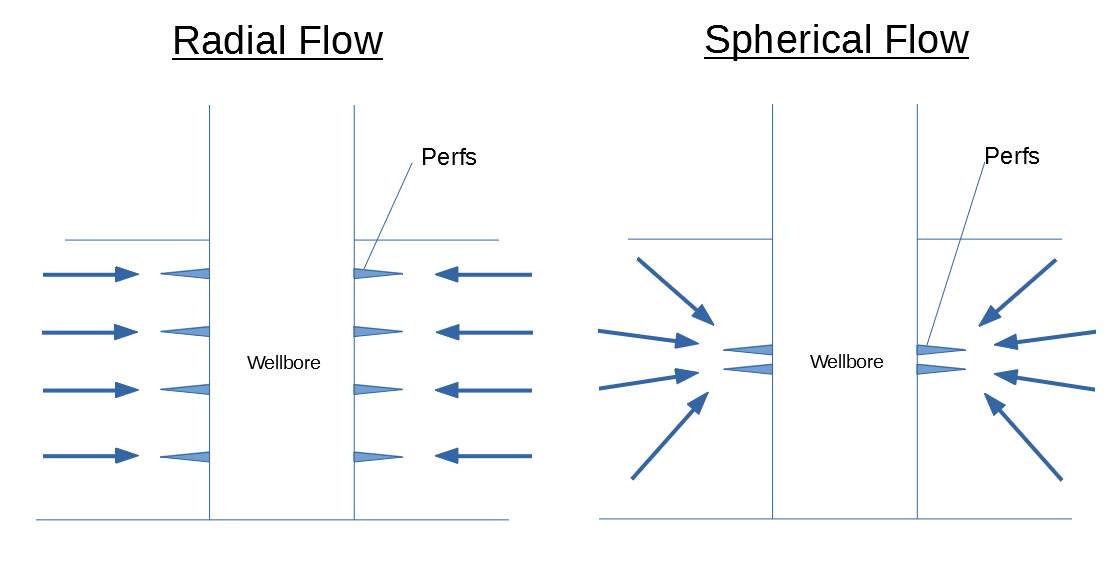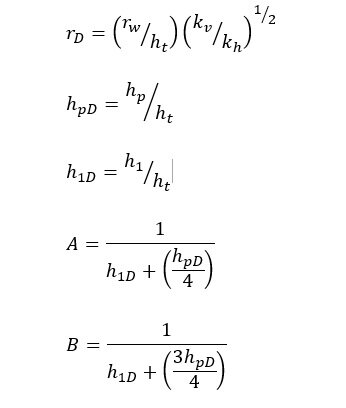Want to read more? Click here for more Well Insights.
SKIN DUE TO PARTIAL PENETRATION
A common cause of skin in a well is due to partial penetration. This occurs for one of two reasons:
1. The wellbore is only partially penetrating the pay zone
2. The perforated interval only covers part of the pay zone
Partial penetration causes skin because it forces the reservoir fluids into spherical (or hemispherical) flow, rather than radial flow. Spherical flow is less efficient than radial flow for several reasons. First, the fluids are constricted near the wellbore in three dimensions (x, y and z-axis) as opposed to just two dimensions (x and y-axis) in radial flow. The image below represents this flow constriction in spherical flow compared to radial flow.
The second reason that spherical flow is less efficient is a result of the difference in horizontal versus vertical permeability. In many reservoirs, the sediment is laid down in horizontal bedding planes, which causes the sediment grains to be oriented in the x-y plane and stacked like bricks. This results in a much higher horizontal permeability than vertical permeability. A common rule of thumb is that the horizontal permeability is about 100 times greater than the vertical permeability. In spherical flow, some of the reservoir fluids are forced to travel vertically to reach the wellbore, and when they do, they have 100 times more resistance to flow.
Due to these inefficiencies, spherical flow will create a much greater pressure drop through the reservoir than would be expected in radial flow. The result is a positive skin.
The following equation for skin due to partial penetration can be found in the SPE book, “Pressure Transient Testing”, by Lee, Rollins and Spivey:
Where:
How To Fix Skin Due To Partial Penetration
Once skin due to partial penetration has been identified, the next step is to determine the specific cause so that it can be fixed. As mentioned above, skin due to partial penetration has two causes: a partially drilled hole and a lack of perforations. To determine the specific cause, drilling and completion records must be analyzed, so that corrections can be made.
Partially Drilled Hole
While this is not a common issue in modern wells, it is common to find this in old wells, particularly in gas storage wells. Typically, this issue occurs if the well was drilled with cable tools and the drilling was stopped before the bottom of the pay zone was reached due to high gas rates blowing the cable tools out of the hole (things were different back then!). In these situations the solution is simply to deepen the well with a rig.
Lack of Perforations
This is a much more common occurrence in modern, cased-hole wells. This occurs when either the perforated interval only covers part of the pay zone height, or the perforations are spaced too far apart across the pay interval. This creates a choke point near the wellbore and forces some of the reservoir fluids to travel vertically. The solution here is simple – add more perforations. Adding more perfs will allow for radial flow rather than spherical flow. The result is less pressure drop near the wellbore.
Skin due to partial penetration can rob a well of its full production potential. Identifying partial penetration with a well test is the first step in improving well performance.
Want to read more? Click here for more Well Insights.
You can also subscribe to receive Well Insights updates directly to your inbox.





